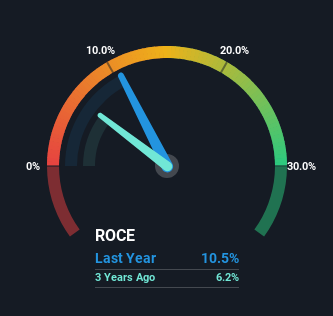Babcock & Wilcox Enterprises (NYSE:BW) Is Doing The Right Things To Multiply Its Share Price
There are a few key trends to look for if we want to identify the next multi-bagger. Amongst other things, we'll want to see two things; firstly, a growing return on capital employed (ROCE) and secondly, an expansion in the company's amount of capital employed. Basically this means that a company has profitable initiatives that it can continue to reinvest in, which is a trait of a compounding machine. Speaking of which, we noticed some great changes in Babcock & Wilcox Enterprises' (NYSE:BW) returns on capital, so let's have a look.
What Is Return On Capital Employed (ROCE)?
For those who don't know, ROCE is a measure of a company's yearly pre-tax profit (its return), relative to the capital employed in the business. To calculate this metric for Babcock & Wilcox Enterprises, this is the formula:
Return on Capital Employed = Earnings Before Interest and Tax (EBIT) ÷ (Total Assets - Current Liabilities)
0.10 = US$47m ÷ (US$837m - US$394m) (Based on the trailing twelve months to September 2023).
So, Babcock & Wilcox Enterprises has an ROCE of 10%. That's a relatively normal return on capital, and it's around the 13% generated by the Electrical industry.
View our latest analysis for Babcock & Wilcox Enterprises
In the above chart we have measured Babcock & Wilcox Enterprises' prior ROCE against its prior performance, but the future is arguably more important. If you'd like, you can check out the forecasts from the analysts covering Babcock & Wilcox Enterprises here for free.
What Does the ROCE Trend For Babcock & Wilcox Enterprises Tell Us?
Babcock & Wilcox Enterprises has broken into the black (profitability) and we're sure it's a sight for sore eyes. The company now earns 10% on its capital, because five years ago it was incurring losses. Interestingly, the capital employed by the business has remained relatively flat, so these higher returns are either from prior investments paying off or increased efficiencies. With no noticeable increase in capital employed, it's worth knowing what the company plans on doing going forward in regards to reinvesting and growing the business. Because in the end, a business can only get so efficient.
On a separate but related note, it's important to know that Babcock & Wilcox Enterprises has a current liabilities to total assets ratio of 47%, which we'd consider pretty high. This can bring about some risks because the company is basically operating with a rather large reliance on its suppliers or other sorts of short-term creditors. Ideally we'd like to see this reduce as that would mean fewer obligations bearing risks.
In Conclusion...
To bring it all together, Babcock & Wilcox Enterprises has done well to increase the returns it's generating from its capital employed. Astute investors may have an opportunity here because the stock has declined 62% in the last five years. With that in mind, we believe the promising trends warrant this stock for further investigation.
Like most companies, Babcock & Wilcox Enterprises does come with some risks, and we've found 2 warning signs that you should be aware of.
For those who like to invest in solid companies, check out this free list of companies with solid balance sheets and high returns on equity.
Have feedback on this article? Concerned about the content? Get in touch with us directly. Alternatively, email editorial-team (at) simplywallst.com.
This article by Simply Wall St is general in nature. We provide commentary based on historical data and analyst forecasts only using an unbiased methodology and our articles are not intended to be financial advice. It does not constitute a recommendation to buy or sell any stock, and does not take account of your objectives, or your financial situation. We aim to bring you long-term focused analysis driven by fundamental data. Note that our analysis may not factor in the latest price-sensitive company announcements or qualitative material. Simply Wall St has no position in any stocks mentioned.

